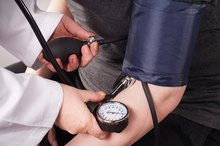What does fact checked mean?
At Healthfully, we strive to deliver objective content that is accurate and up-to-date. Our team periodically reviews articles in order to ensure content quality. The sources cited below consist of evidence from peer-reviewed journals, prominent medical organizations, academic associations, and government data.
The information contained on this site is for informational purposes only, and should not be used as a substitute for the advice of a professional health care provider. Please check with the appropriate physician regarding health questions and concerns. Although we strive to deliver accurate and up-to-date information, no guarantee to that effect is made.
Health Side Effects of Salt
Salt, scientifically known as sodium chloride, is a mineral essential to life, according to the National Institute of Health. In the human body, sodium controls the volume of body fluid, helps to maintain electrolyte balance, and is an integral part of proper nerve and muscle function. Although sodium is necessary to sustain human life, consuming too much or too little salt can have negative health side effects.
Too Much Salt
The overconsumption of salt is becoming increasingly common in the American diet, according to the U.S. Department of Agriculture. The most well-known side effect of too much salt is hypertension, or high blood pressure. An excess of salt causes blood vessels to constrict, which is dangerous because the heart is required to work harder to pump blood throughout the body. Prolonged hypertension increases the risk of heart disease, heart failure, stroke, and kidney disease. Another side effect of too much salt is edema, a swelling of the body, usually seen in the hands and legs. Edema occurs when the body retains an excess of fluid in an attempt to balance out the extra sodium.
- The overconsumption of salt is becoming increasingly common in the American diet, according to the U.S. Department of Agriculture.
- Another side effect of too much salt is edema, a swelling of the body, usually seen in the hands and legs.
Too Little Salt
Is Sodium Bad For You?
Learn More
Although not as common, too little salt also can have negative health side effects. That condition, called hyponatremia, is most often caused by the use of diuretics or severe diarrhea or vomiting 4. In less common occurrences, hyponatremia can be caused by not eating enough salt, excreting too much sodium through prolonged exercise (such as marathon running), or drinking too much water 4. Early symptoms of having too little salt in the body include:
- fatigue
- confusion
- headache
- nausea
- muscle cramps
- a loss of appetite
- according to the Mayo Clinic
More severe symptoms are seizures and coma.
Recommendations
The USDA sets the dietary guideline for salt for the average person at no more than 2,300 mg, or 1 tsp., per day. That recommendation decreases for those with existing heart problems or high blood pressure. An individual will either be put on a 1,000 mg, 2,000 mg or “NAS” ("no added salt") diet, depending on his or her specific condition.
Related Articles
References
- MedlinePlus: Sodium in Diet
- Dietary Guidelines for Americans 2005: Chapter 8 Sodium and Potassium
- FAQS.org: Sodium Imbalance
- MedlinePlus: Hyponatremia
- Food and Drug Administration, Center for Food Safety and Applied Nutrition. You May Be Surprised by How Much Salt You're Eating. Consumer Updates, 2016
- Sea salt vs. table salt, Break Up with Salt. American Heart Association.
Writer Bio
Lindsay Boyers has a Bachelor of Science in nutrition from Framingham State College and a certificate in holistic nutrition from the American College of Healthcare Sciences. She is also a licensed aesthetician with advanced training in skincare and makeup. She plans to continue on with her education, complete a master's degree program in nutrition and, ultimately, become a registered dietitian.









